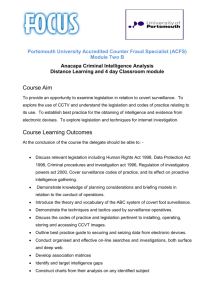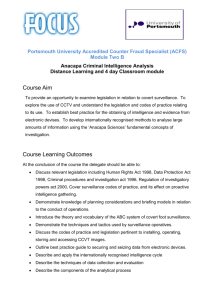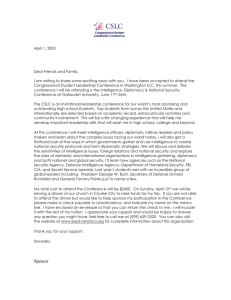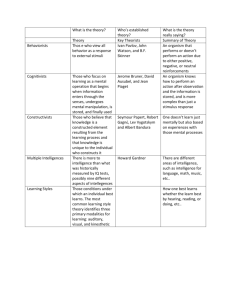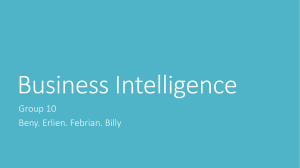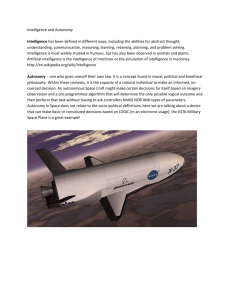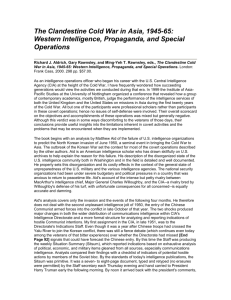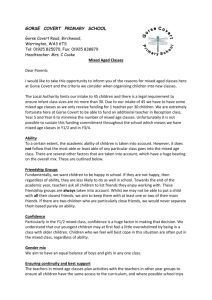“Covert Action” as a Foreign Policy Tool of the US:
advertisement
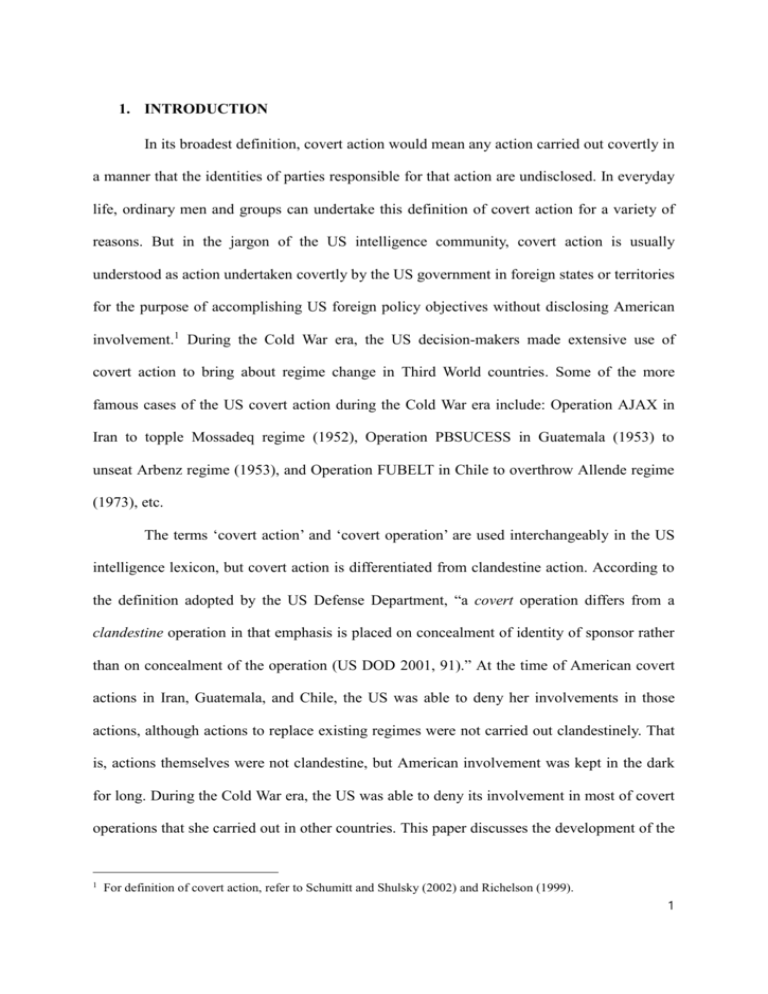
1. INTRODUCTION In its broadest definition, covert action would mean any action carried out covertly in a manner that the identities of parties responsible for that action are undisclosed. In everyday life, ordinary men and groups can undertake this definition of covert action for a variety of reasons. But in the jargon of the US intelligence community, covert action is usually understood as action undertaken covertly by the US government in foreign states or territories for the purpose of accomplishing US foreign policy objectives without disclosing American involvement.1 During the Cold War era, the US decision-makers made extensive use of covert action to bring about regime change in Third World countries. Some of the more famous cases of the US covert action during the Cold War era include: Operation AJAX in Iran to topple Mossadeq regime (1952), Operation PBSUCESS in Guatemala (1953) to unseat Arbenz regime (1953), and Operation FUBELT in Chile to overthrow Allende regime (1973), etc. The terms ‘covert action’ and ‘covert operation’ are used interchangeably in the US intelligence lexicon, but covert action is differentiated from clandestine action. According to the definition adopted by the US Defense Department, “a covert operation differs from a clandestine operation in that emphasis is placed on concealment of identity of sponsor rather than on concealment of the operation (US DOD 2001, 91).” At the time of American covert actions in Iran, Guatemala, and Chile, the US was able to deny her involvements in those actions, although actions to replace existing regimes were not carried out clandestinely. That is, actions themselves were not clandestine, but American involvement was kept in the dark for long. During the Cold War era, the US was able to deny its involvement in most of covert operations that she carried out in other countries. This paper discusses the development of the 1 For definition of covert action, refer to Schumitt and Shulsky (2002) and Richelson (1999). 1 US covert action and its place in American intelligence activities and the impact that 911 terror incident had on transformation of US intelligence community and policies. 2. COVERT ACTION IN THE US INTELLIGENCE ACTIVITIES 2.1 The US Intelligence Community and Intelligence Activity Often times ordinary laymen tend to think the CIA is the only intelligence of the US that single-handedly takes charge of entire gamut of US intelligence activities, but the CIA is only one of 16 intelligence agencies that make up the US Intelligence Community. To understand the nature and motivations of US covert action, it is important to assess development of US Intelligence Community, the role of covert action in US intelligence activity, and the CIA that is in charge of running US covert action. According to Grady (2005) intelligence activities are, in the most general sense, organized into four functional areas: Intelligence Collection, Analysis, Counterintelligence, and Covert Action. In terms of the methods used for intelligence activities, intelligence activities can also be divided into Technical Intelligence (TECHINT) and Human Intelligence (HUMINT) activities. TECHINT relies on technologies such as super computers and satellites, whereas human spies carry out HUMINT. The role of human spies is critical to carry out effective HUMINT. Among the many intelligence agencies of the US, it is the CIA that is in charge of running American covert action. The CIA and US intelligence community In order to understand the place of covert action in US foreign policy in general and US intelligence activity in specific, it is important to trace the evolution of the CIA since the CIA has been in charge of running US covert action programs. It is also important to place 2 the CIA in the big picture of US intelligence community to understand the roles that the CIA plays for US intelligence activity. Arguably, there exist sixteen US intelligence agencies that make up the US Intelligence Community.2 It is true that the CIA has functioned as the lead intelligence agency for the US, but it is one of sixteen intelligence agencies in the US. Among sixteen intelligence agencies, the CIA is the only independent agency not affiliated with other governmental departments or branches of the military.3 That is, except the CIA, other US intelligence agencies are under the auspices of one of the following US governmental departments: the Department of Defense (DOD), the Department of State (DOS), the Department of Justice (DOJ) and the Department of Homeland Security (DHS). Although the CIA is the best known member of the US Intelligence Community, the bulk of the nation’s intelligence effort is undertaken by the intelligence agencies of the DOD (Best 2004, 2). The DOD oversees eight intelligence agencies: the National Security Agency (NSA), the National Reconnaissance Office (NRO), the National Geospatial-Intelligence Agency (NGA), the Defense Intelligence Agency (DIA), the Intelligence and Security Command (INSOCOM), the Office of Naval Intelligence Activity (ONI), the Air Intelligence Agency (AIA), and the Marine Corps Intelligence (MCIA). Under the auspice of DOJ are the Federal Bureau of Investigation (FBI) and the Drug Enforcement Agency (DEA). The Bureau of Intelligence and Research (INR) belongs to the Department of State. DHS, responsible for safeguarding the territory of the US from terrorist attack and responding to natural disasters, oversees two intelligence agencies: the Information Analysis and Infrastructure Protection Directorate (IAIP) and the United States Coast Guard (USCG). 2 See United States Intelligence Community, http://www.intelligence.gov. However, after the Intelligence Reform and Terrorism Prevention Act of 2004, the Office of the Director of National Intelligence (ODNI) was established. If we count the ODNI as independent agency, the number of independent US intelligence agencies amount to two, not one. 3 3 After the 911 incident, President Bush established the National Counterterrorism Center (NCTC) in August 2004. The NCTC was to serve as the primary organization in the US government for integrating and analyzing all intelligence pertaining to terrorism and counterterrorism (CT) and to conduct strategic operational planning by integrating all instruments of national power.4 Afterwards, the US Congress passed the Intelligence Reform and Terrorism Prevention Act of 2004 (IRTPA) in order to reform the intelligence community and the intelligence and intelligence-related activities of the US government.5 The most remarkable change that was made in US intelligence after IRTPA was the creation of the office of the Director of National Intelligence (DNI). The DNI replaced the Director of Central Intelligence (DCI) as the leader of the US Intelligence community.6 The DNI plays the role of the principal advisor to the President (particularly through daily brief to the President), the National Security Council, and Homeland Security Council for matters related to intelligence.7 Before the 2004 IRTPA the US intelligence community looked like <Figure 1>. <Figure 2> is how the US intelligence community is organized after 2004 IRTPA . The origin and development of the CIA The CIA, as lead intelligence agency of the US, plays an integral role for the US 4 See National Counterterrorism Center, http://www.nctc.gov. The Intelligence Reform and Terrorism Prevention Act of 2004 is divided into eight components: (1) Reform of the intelligence community, (2) Federal Bureau of Investigation, (3) Security clearances, (4) Transportation security, (5) Border protection, immigration, and visa matters, (6) Terrorism prevention, (7) Implementation of 911 Commission recommendations, (8) Other matters. From National Counterterrorism Center (December 17, 2004). 6 The DCI was the Director of the the CIA, but at the same time, the DCI was the leader of the US Intelligence Community. As the leader of US intelligence community, the role of DCI was to coordinate and integrate different intelligence activities of different US intelligence organization. But the DCI’s role as the head of the CIA limited the role of DCI as leader of US Intelligence Community. Lack of coordination of integration of US intelligence was considered one of the reasons for not being able to prevent 911. According to Tim Weiner of New York Times, the CIA wrongfully assessed that Saddam Hussein possessed weapons of mass destruction (WMD). When Tenet, the then DCI finally acknowledged what he reported was not true, White House, the DOD, and DOS were highly infuriated. This led George W. Bush to decide to create office of DNI. (Chosun.com, Interview with Tim Weiner, September 17, 2007). John Negroponte became the first DNI and then Mr. J. M. McConnell became the second DNI of the US. 7 For further information, http:// www.intelligence.gov. 5 4 intelligence. How did the CIA come into existence? How did it evolve? To understand the nature of covert action, it is important to explore more about the origin and the development of the CIA, since the CIA is in charge of US covert action. Before World War II, the level of US intelligence collection, analysis, and operations were rudimentary at best. To make matters worse, the US before WWII, did not have an independent intelligence agency. This made it difficult for the US government to control and coordinate intelligence results collected and assessed by different agencies through various routes. The attack on Pearl Harbor on December 7, 1941, was an eye-opener for the US policymakers. Although the US navy was running decryption program against the Japanese navy, it was not able to predict the surprise attack on Pearl Harbor. Failure to predict the Pearl Harbor attack was considered the most egregious intelligence failure in US history, thereby leading the US government to conduct sweeping reforms on the US intelligence system. First, it was critical to coordinate and control various US intelligence activities. As a result, President Franklin D. Roosevelt created the Office of Coordinator of Information (COI) to supervise the US intelligence community. William Donovan served as the first COI, the responsibility of which included reporting the intelligence collected and analyzed to the president. Later the COI reorganized into the Office of Strategic Service (OSS). The OSS was created to replace the COI, but in addition to this, the OSS was granted with another special mission.8 This “special mission” of OSS later evolved into US covert action. After WWII, President Harry S. Truman dissolved the OSS in September of 1945. In recognition of the need for new intelligence system, the Truman administration established the Central Intelligence Group (CIG) and the Director of Central Intelligence (DCI) at the same time. And the National Security Act of 1947 created the CIA. To cope with the threats 8 Special mission of OSS during the WWII included secretly setting up the rebel troops and supporting countergovernment force in some enemy countries such as Germany, Japan, and Italy. 5 of the Soviet Unions, Truman concluded that the US should be able to launch covert action, thereby creating the Office of Special Projects. This new office was incorporated into the CIA, but this office was not placed under the control of the DCI; the Secretary of State, not the DCI appointed the director of this office. In addition, both the DOS and the DOD sent representatives to this office to keep the CIA in check. The structure of the CIA was stabilized during Walter B. Smith’s tenure as the DCI. Smith restructured the existing organizations and created the Directorate of Plans in 1952, which was in close cooperation with US Army Special Forces that was also founded in the same year. 2.2 Development of the US Covert Action So far this paper has assessed the nature of US intelligence, composition of US intelligence community and development of the CIA. If we are to evaluate the motives of the US decision makers to use covert action as a tool of the US foreign policy during the Cold War, it is important to understand what covert action is. The pages that follow discuss what is meant by covert action, types of covert action, and cases of US covert action during the Cold War era. The notion of covert action Covert action has been used as an important foreign policy tool of the US since WWII (Godson 1995). According to the definition of Schmitt and Shulsky (2002, 75), “covert action refers to the attempt by one government to pursue its foreign policy objectives by conducting some secret activity to influence the behavior of a foreign government or political, military, economic, or societal events and circumstances in a foreign country.” Richelson (1999, 349) points out that “a covert action includes any 6 operation designed to influence foreign governments, persons, or events in support of the sponsoring government’s foreign policy objectives, while keeping the sponsoring government’s support of the operation secret.” Covert action should be understood as “all activities conducted pursuant to this directive which are so planned and executed that any US Government responsibility for them is not evident to unauthorized persons and that if uncovered the US Government can plausibly disclaim any responsibility for them”(NSC 5412, quoted in Keane and Warner 2007).9 The term, “covert war” is used when US covert operations or covert actions are conducted on a large scale. During the Cold War, the US covert operations conducted by the CIA included: (1) political advice and counsel; (2) subsidies to individuals; (3) financial support and technical assistance to political parties or groups; (4) support to private organizations, including labor unions and business firms; (5) covert propaganda; (6) training of individuals; (7) economic operations; and (8) paramilitary or political action operation designed to overthrow or support a regime; and up until the mid-1960s, (9) attempted assassination.10 These special activities affect the actions of foreign governments or events in foreign countries with political objectives. The objectives usually include the overthrow of a regime or defeat of insurgent force through a civil war or a coup by supporting counter-government force secretly. The New York Time on April 18, 2002 reported that the Bush administration attempted to overthrow President Hugo Chavez regime of Venezuela. 11 According to International Herald Tribune (IHT) on May 30, 2007, the Bush administration was alleged Keane and Warner (2007), “The Intelligence Community 1950-1955,” available at http://www.state.gov/documents/organization/96778.pdf (Search date: October 15, 2008). 10 Available at http://www.answers.com/topic/central-intelligence-agency (Search date: October 20, 2008). 11 Jennifer Mccoy, “Chavez’s Second Chance,” New York Times, April 18, 2002. 9 7 to have planned a covert operation to disturb Ahmadinejad regime of Iran.12 IHT on January 12, 2008 wrote: “President Pervez Musharraf of Pakistan warned that any unilateral attacks by the US against Al Qaeda and Taliban fighters in his country’s tribal areas would be treated as an invasion.”13 The statement made by Musharraf suggests that the US was suspected of planning covert action in Pakistan. Nonetheless, the Bush administration was able to deny the allegations above that US was involved, and its denial seemed plausible. In order for covert operations to be successful, it is imperative for the US to be able to deny American involvement in such operations. That is, it is important to be able to maintain “plausible deniability.” In other words, when a government carries out a covert action, the operation must be done in such way that the government can claim that it knows nothing about it (Grady 2005). Covert operations that the US has conducted can be classified into three groups: political action program, propaganda, and paramilitary activity. The US uses “political action program” to counteract or overthrow a regime or influence the result of an election for defeat of a particular candidate by secretly funding an opposition party. The US has used propaganda to influence events in opposing states by manipulating media and public opinion. This operation is sometimes called “black or unattributed propaganda.”14 For instance, the CIA can employ a foreign reporter to write an article which is never true or fabricate the mass media such as radio or a television. Through paramilitary activity the CIA supports illegal insurgents or armed groups with US military equipments, training, and of course Shirin Ebadi and Muhammad Sahimi, “The follies of Bush’s Iran policy,” International Herald Tribune, May 30, 2007. 13 Eric Schmitt, “Musharraf warns U.S. not to attack within Pakistan,” International Herald Tribune, January 12, 2008. 14 “Propaganda” did not have negative connotations before extensive use of it against enemy countries during WWII. Propaganda denoted the US government activity to influence public opinion by providing correct information. During World Wars, however, this term came to denote activity to diffuse “forged” information to change public opinions and perceptions. Since then, “black (or unattributed)” propaganda and propaganda began to be used interchangeably. 12 8 money. These people or groups are expected to wage proxy wars for the US in the target countries of US covert action. Cases of US covert action during the Cold War era The US has made extensive use of covert action during the Cold War era. The chart in <Figure 3> is the list of “successful” covert action to assassinate state’s leader or to overthrow state’s regime. Small scale covert operations are left out on this list. The list is by no means complete, since truly successful US covert actions would not have been known to the public. The list includes only the cases of US action that are generally accepted as confirmed cases of US covert action. 3. THE US INTELLIGENCE AND COVERT ACTION IN THE POST-COLD WAR ERA The US intelligence apparatus, particularly those in charge of covert operations, played vital roles to defend and promote US interests during the Cold War era. Nonetheless, as the Cold War international order was drawing to a close, covert action was increasingly becoming less attractive foreign policy means. But the 911 terror incidents brought back covert action to the forefront of American War against Terror. The objective of this section of the paper is to discuss the roles that US covert action has played for the American War on Terror and to assess the major changes that the US intelligence policies have undergone since the end of the Cold War. In so doing, the paper will briefly assess the new roles that US covert action has played in the age of terror. 3.1 Crisis of Covert Action and the CIA toward the End of the Cold War The US is inherently a liberal state. Before Cold War competition with the Soviet Union 9 justified heavy militarization of the country, American people in general never really felt comfortable about possessing huge military institutions and large standing army in peace time. Americans felt that the large military presence in the country would ultimately undermine civil liberties at home and lead to militarization of society and culture. From the founding days of the nation until the late 19th century US foreign policy stance was virtually isolationist in nature. American elites and public believed that active foreign policy would lead to strengthening of the power of the federal government at the sacrifice of individual liberty and autonomy of local government. Outbreak of WWI justified active foreign policy role of the US, but still the mass public of the US was not enthusiastic about entering what they perceived as basically a European war. President Wilson had a hard time mobilizing American public support for American participation in WWI, because many Americans did not view any core national interests at stake in the war-torn continent of Europe that required American military commitment. German indiscriminate submarine attack and subsequent American casualties that it incurred provided rationales for Wilson to call for “war to save democracy.” But after the WWI was over, the US quickly demobilized the military and sank into isolationist foreign policy mood. Woodrow Wilson lost the presidential election to Republican presidential candidate, Warren Harding who ran his campaign under the banner of “return to normalcy.”15 Of course, “normalcy” was a liberal country with limited military presence and isolationist foreign policy posture. As with the outbreak of WWII, the US once again broke from the tradition of isolationism and became an active participant of world affairs. After WWII the country was about to revert to isolationist. However, ensuing competition with the Soviets and heightened security threat of the Cold War justified heavy military buildup and strengthening security “HARDING FOR WORLD COURT; Would Confer With Nations But Make No Advance Commitments,” New York Times, March 5, 1921. 15 10 apparatuses. As discussed earlier, the US intelligence policies and apparatuses before WWII were not that magnificent. The UK, not the US, was considered the leading country in intelligence policies and activities before WWII. But the US restructured its intelligence community, policies, and activities during and after the WWII, thereby coming to possess the most advanced intelligence capabilities in the post WWII era. As mentioned earlier, the US decision makers made extensive use of covert action during the Cold War as a middle option between diplomacy and open military aggression. Still some Americans had qualms about using covert action as a foreign policy tool of the ‘liberal democratic’ United States. One of the key characteristics of democracy is the ability of mass public to hold decision making elites accountable for the policy actions. In a liberal democracy, policy decisions are supposed to be arrived at after open public discussion about the properness of suggested policies. After the open public debates, the elites implement policies favored by the majority of public. If elites decide policies that do not reflect the majoritarian will of the people, they should be held accountable for those policies. But covert action intentionally obviates public scrutiny over the policies; covert action allows elites to circumvent due process of checks and balances and open public debate over the policies. How can people hold elites accountable for the policies when they do not even know the existence of those policies? Here lies the dilemma of covert action in democracy. If we take away “covert” part of covert action, it is not covert action anymore. But if elites keep covertness of covert action, covert action violates one of the cardinal norms of democracy: “accountability.” But by and large security threats posed by Soviet communism rationalized the use of covert action in liberal democratic US. For instance, General Doolittle and his committee concluded in their report to Eisenhower on October 19, 1954: “It is now clear that we are facing an implacable enemy whose avowed objective is world domination by whatever means and at whatever cost. There are no rules in 11 such a game. Hitherto acceptable norms of human conduct do not apply. If the United State is to survive, long standing American concepts of “fair play” must be reconsidered. We must develop effective espionage and counterespionage services and must learn to subvert, sabotage and destroy enemies by more clever, more sophisticated means than those used against us. It may become necessary that the American people be made acquainted with, understand and support this fundamentally repugnant philosophy.”16 With the demise of Cold War competition with the Soviet, covert action lost much of its appeal as a legitimate foreign policy tool of the US. First of all, after its archenemy is gone, the CIA was going through an identity crisis. Raison d’être of the CIA was to fight against Soviet communism; therefore collapse of Soviet Union was indeed an event that disoriented the CIA with regard to its future responsibilities. Second, as many covert wars that the CIA had waged in foreign countries became public knowledge, Americans became disenchanted with nature and methods that the CIA used to intervene in domestic affairs of other countries. The US lost respect because of notorious dirty tricks (i.e., covert action) that the CIA played. The CIA covert action, although it accomplished its short-term political objectives, sowed seeds for anti-American sentiments in the longer run in many parts of the world. For these reasons, the CIA earned a nickname, “rogue agency” in the US. Third, the technological revolution, with the rising importance of TECHINT (i.e., SIGINT and IMINT, etc), has degraded the status of the CIA as the lead intelligence agency of the US. Indeed, the end of the Cold War was the major challenge not only to the CIA and covert action but to the US intelligence community as a whole. The Clinton administration reduced the military budget (hence intelligence budget) as Clinton promised during the election campaign.17 American people felt that the burden for international peace as well as the budget for intelligence community should be cut down (Hass 1994, 7). The the CIA and 16 Dwight D. Eisenhower, Secret To James Harold Doolittle, July 26, 1954, in The Papers of Dwight David Eisenhower, ed. L. Galamobos and D. van Ee, doc 993, quoted in Leary, ed., (1984, 144). 17 For further information, William O. Studeman, “Remarks by Admiral William O. Studeman, Acting Director of Central Intelligence at Marquette University,” available at https://www.cia.gov/news-information/speechestestimony/1995/dci_speech_42095.html (Search date: October 27. 2008). 12 other intelligence organizations were struggling to redefine the scope of their activities, size and responsibilities. But after 911, the US foreign policy circle came to an understanding that the most sensitive intelligence information can be retrieved and analyzed only by human spies. As the 911 commission report points out, “A principal conclusion is that the US human intelligence capability must be improved across the board.”18 And to infiltrate and subvert terrorist networks and the regimes that harbor them, the US is once against beefing up HUMINT to fight war against international terrorism and terrorists. Covert action, which had become virtually obsolete after the Cold War (mainly because of its morally repugnant nature), seems to have re-emerged as a necessary foreign policy tool to defend American national interests from the enemies whose avowed objective is hurting the US by whatever means and at whatever costs. The roles that American covert action had played both in Afghanistan War and Iraq War testifies to the fact that covert action is back as legitimate foreign policy tool of the US in this war against terrorism. The War against Terror once again justified use of covert action as legitimate foreign policy tools of the US. Let us briefly examine the roles that covert action played in the Afghanistan and Iraq wars. 3.2 War against Terrorism and the CIA Covert Action Bush’s War on Terror first started against the Taliban regime in Afghanistan who harbored Osama bin Laden and Al Qaeda and unwilling to relinquish them to the US. The American aerial bombing started on October 7, 2001 and it lasted for about 40 days. After aerial bombing, the US kicked off the ground war. The US military operation on the ground turned out to be a very swift and decisive victory for the US. Within a month, the US toppled the Taliban regime and drove the Taliban out of Kabul, the Afghanistan Capital. Then the US 18 Eric Schmitt, “Pentagon Sends Its Spies to Join Fight on Terror,” New York Times, January 24, 2005. 13 army forces swept over fortified cities of Kunduz and Kandahar in less than two months. Some claimed that the overwhelming superiority of air power basically won the war for the US before the ground war kicked off. For instance, Loren Thompson, a military analyst at the Lexington Institute in Arlington, said, “Air power has enabled us [United States] not only to win quickly, but to do it humanely... We get the war over quickly and, generally speaking, we don’t hit civilians.”19 Others claimed that American ground forces equipped with smart weapons of surgical precision brought the swift triumph for the US. As John Pike, one of the world’s leading experts on defense, space and intelligence policy, pointed out, “new US “smart bombs” are much more accurate than those used in the Gulf War 10 years ago or even in Kosovo two years ago. US surveillance technologies are more efficient at finding targets. The time between spotting a target and dropping a bomb on it, which a decade ago took days, is now a matter of minutes.”20 However, before the invasion, quite a few military experts anticipated a long and drawn out warfare that would produce substantial American causalities. First, Talibans were warriors for life time; fighting warfare has been an important part of their daily lives. More importantly, Afghanistan has one of the world’s harshest geography with hillsides and valleys of caves. This geography of the country makes it perfect setting for the Talibans to hide and wage the kind of long and dreary guerrilla warfare. Aerial bombing had limited effect on enemies – Talibans – who were hiding caves and valley. There is a limit to which air power can destroy enemy forces when these enemy forces are in static defensive position, although Nancy Benac, “War in Afghanistan demonstrates air power’s new ability,” The Associated Press, December 19, 2001, available at http://www.globalsecurity.org/org/news/2001/011219-attack02.htm (Search date: December 10, 2008); More opinions of military experts are available at http://www.globalsecurity.org/org/news/2001/011121-attack02.htm (Search date: December 10, 2008). 20 Fred Kaplan, “High-Tech US Arsenal Proves its Worth,” The Boston Globe, December 9, 2001, available at http://www.globalsecurity.org/org/news/2001/011209-attack01.htm (Search date: December 10, 2008). 19 14 aerial bombing can be lethal against enemies on the move. 21 The Washington Post reported on Nov 2, 2001 “the attacks have not eliminated any measurable number of Taliban troops…. a major chunk of the 50,000 Taliban army and much of its arsenal are pretty much intact after three weeks of bombing.” State of the art weapons with surgical precision also have limited effects in guerrilla warfare. Russians warned the US of the difficulty of the ground war in Afghanistan because they experience humiliating defeat in Afghanistan in late 1980s, hence the nickname of Afghanistan, “soviet graveyard.”22 The swift victory owes much to US covert action that initiated in Afghanistan months before Bush declared War against the Taliban. Before the war was declared, the US sent several hundred the CIA operatives to Afghanistan to launch covert action to topple Taliban regime. President Bush signed a series of directives authorizing the CIA to conduct a covert war against Osama bin Laden’s Al Qaeda network after the 911 attacks.23 With the authority to kill or capture Al Qaeda leaders, the CIA agents infiltrated into Afghanistan and launched covert operations. One of their missions was to set up a connection with Northern Alliances, tribal militias and archrivals of Talibans in Afghanistan. Northern Alliances were very much eager to retake power from the Taliban in Afghanistan. The the CIA operatives provided the Northern Alliances monetary aids and military equipments. This covert action carried out in Afghanistan was a typical case of paramilitary action, the kind of covert action undertaken in Nicaragua by the Reagan administration in early 1980s. Logistical help provided by the Northern Alliance proved to be critical for US military victory because they were familiar 21 Aerial bombing of coalition forces in Kosovo and during the first Gulf War had limited effects as well because the enemies were in static defensive position. 22 In 1979, the Soviet Army carried out a conventional assault on Kabul in order to depose President Amin and establish the new Afghan government of Babrak Karmal. But The Soviets finally failed to control over Afghan because they knew neither their enemies nor the Afghan natural environment. Salin (2007), “The Soviet Intervention in Afghanistan between 1979 and 1989.” 23 “ The Struggle for Iraq: Detainees; Harsh C.I.A. Methods Cited In Top Qaeda Interrogations,” New York Times, May 13, 2004. 15 with the maze-like geography in the region. American War in Afghanistan to topple Taliban regime was in fact proxy war; the Northern Alliances were American proxy forces and they took the lead in American ground operations in Afghanistan war. The CIA also confirmed that they sent several hundred operatives to Afghanistan to collect information and to set up connection with the Northern Alliances. In fact, the first American casualty in Afghanistan was not a regular member of the US army, but a CIA operative, Johnny Spann. This attests the depth and intensity of American covert action in Afghanistan.24 In March of 2003, military front of Bush’s War on Terror moved to Iraq. The American invasion started with massive aerial bombing that lasted for about 3 days. After Shock and Awe, massive aerial bombing, the US ground forces entered Iraqi territories. It was anticipated that ground operations would produce sizeable American casualties and might drag on for long period of time. Because unlike the 1st Gulf War where most of the battles took place in open deserts, the 2nd Gulf War (or Iraq War) had to be fought in the streets of Baghdad and other major cities of Iraq. During the 1st Gulf War, open desert was perfect terrain that worked to the advantage of the American ground troops equipped with state of the art weapons. The objective of the 1st Gulf War was to drive Iraqi soldiers out of Kuwait. The objective of the 2nd Gulf War was to topple the Hussein regime. Resistance of Iraqis was expected to be more desperate than the 1st Gulf War. More than anything else, the warfare during the 2nd Gulf War was expected to take on the nature of bare-knuckle street fights where state of the art weaponry of the US forces would have limited effects. But contrary to the expectations of many, overthrowing Hussein regime and claiming Baghdad was much 24 But American ground operations to capture or kill Osama bin Laden and remnants of Al Qaeda and Talibans was not successful. Northern Alliances, once overtaking power in Afghanistan, were more interested in consolidating power in Afghanistan rather than helping Americans pursue additional objectives of rounding up remnants of Al Qaeda and Talibans. The US did not commit enough ground troops to accomplish remaining policy objective for fear of putting American soldiers in harm’s way. Also diversion to Iraq War forced the Bush administration to withdraw American military commitments from Afghanistan prematurely. 16 less costly to the American military forces. Swift victory of the US should also be attributed to the CIA covert action that initiated months before the war was declared. Without formal agreement of the UN Security Council, Bush already began a broad range of the CIA covert action at least three months before the war.25 Covert action is back at the forefront of US foreign policy in this age of terror. After a great deal of debate, the Bush administration decided that the CIA should retain responsibility for running covert action for the US. 3.3 The 911 and Creation of National Clandestine Service (NCS) The 911 terrorist attack was the worst intelligence failure in American history. Consequently, it worked as a catalyst to re-appreciate the importance of maintaining proper intelligence capabilities and to restructure American intelligence community and policy. On November 27, 2002, the National Commission on Terrorist Attacks upon the United States (the 911 Commission) was set up at the request o f President Bush and the Congress in order to find out the reasons for not preventing the attack and to fix the US intelligence community and policy. According to the Commission’s final report issued on July of 2004, the chain of intelligence and law enforcement failures were held responsible for not preventing the 911 attacks. The Commission suggested (a) creation of a Director of National Intelligence over both the CIA and the FBI, (b) weakening the role of the CIA and DCI, (c) provision of incentives for sharing intelligence, (d) proper funding for intelligence activities and public accountability of intelligence policies, and (e) plan to place all the paramilitary capabilities of the CIA under the authority of the Pentagon.26 However, leading White House advisory panel, led by the retired Air Force General Duglas Jehl and Dexter Filkins, “AFTER THE WAR: COVERT OPERATIONS; U.S. Moved to Undermine Iraqi Military Before War,” New York Times, August 10, 2003. 26 “THE 911 COMMISSION REPORT ONE YEAR LATER,” Congressional Briefing, July 22, 2005, p.84-88, available at http://www.911truth.org/downloads/McKinney-911Commission-OneYearLater.pdf (Search date: November 17. 2008). 25 17 Brent Scowcroft, was preparing an intelligence reform proposal which tried to strip several intelligence agencies from the Pentagon and empower the CIA director. Under the proposal, the NRO, NIMA, and NSA would each come under the control of the CIA director.27 In the process, Scowcroft was in conflict with the Defense Secretary Donald Rumsfeld because Rumsfeld wanted the DOD to be much more powerful than others. He was even opposed to the idea of creating DNI because the creation of DNI could decrease his power as the Secretary of Defense. In fact, Rumsfeld controlled nearly 80 percent of total intelligence spending, but the control should be shared if the DNI was established.28 The end result of the clash between Rumsfeld plan (or plan advocated by 911 Commission) and Scowcroft plan was a compromise. It was decided that the DOD would retain the NRO, NIMA, and NSA, hence American TECHINT capabilities, while the CIA would remain as the major American HUMINT agency and agency in charge of American covert action. Stepping up the intelligence agency reform, Negroponte, the first DNI, established National Clandestine Service (NCS) in the CIA as a replacement of Directorate of Operations (which was in charge of covert action in the CIA). This meant that the CIA would restructure its covert action responsibilities. Initially, the NCS was supposed to be created under the DNI, but in the end, it was established under the CIA. This decision was critical to the CIA in that the CIA was able to remain as the lead agency running American covert action. Rumsfeld attempted to take covert action responsibilities away from the CIA and place it under the authority of the DOD. But President Bush sided with the CIA and approved the place to create the NCS under the authority of the CIA. However, unlike its predecessor, Directorate of Operations, the NCS enjoys a certain degree of autonomy from the DCIA. <Figure 4> is the CIA organization chart before 2005 reform and <Figure 5> is 27 28 John LeBoutillier, “Rewarding the CIA’s Failure,” Newsmax.com, November 9, 2001. Daniel Eisenberg, “Bush’s New Intelligence Czar,” Time, February 21, 2005. 18 the CIA organization chart after 2005 reform. 3.4 Implications for US Foreign Policy Making American covert action to overthrow legitimate leader of Iran, Mohamed Mossadeq in 1953 was huge success within the American foreign policy circle. Operation AJAX (the code name for American covert action in Iran) was the first attempt for American covert action to unseat popularly supported regime. Operation AJAX set the mold for many more covert actions that followed and instilled the confidence in American decision makers that the US would be able to bring about regime changes with that same ease as Operation AJAX. But the covert action poses an important challenge to democratic principles. In democracy, mass public should be able to constrain decision making processes of elites. Public policies of democracies, be it domestic or international, should be subject to open debates and public scrutiny. If public policies fail to reflect majoritarian will of the population in democracies, decision makers should be held accountable for those policies. But covert action is meant to be hidden from open debates, public scrutiny, and checks and balances inherent in democratic political institutions. Here lies the problem of covert action as legitimate foreign policy tool of democratic state. In the early Cold War era, American decision makers had been quite successful in keeping the domestic as well as international audience in the dark about the nature and scope of American illegal interventions in foreign states that brought about regime changes there. Mass media in the US during the early Cold War period basically followed cues and facts provided by the American government and accepted them without any reservations. For this reason, the American decision makers were able to keep the secrets about American hands in the covert plots toppling legitimate regimes in foreign states. But toward 1980s, the American 19 mass media was becoming increasingly government-challenging. In the wake of the Vietnam War, the American mass media and public alike became skeptical about the credibility and competence of governmental leadership. Hitherto government-friendly American mass media started to investigate the American covert action and instantly blew the cover for the American government. For instance, it was Newsweek that divulged the Reagan administration’s covert action in Nicaragua to wage contra war. American covert action after Reagan’s covert war – contra war – in Nicaragua took on a nature of “overt”-covert war. Since American covert action is no longer “covert” from public scrutiny, American decision makers resort to covert action tends to be limited to the cases where they can garner popular consent for such action afterwards. After the CIA covert action in Afghanistan War, the George W. Bush administration admitted that it did launch covert action in Afghanistan. Public opinion at home and abroad did not denounce covert action in Afghanistan waged by the Bush administration, because such action was not used as an avenue to circumvent public relations risk. This is a testament to the fact that, as long as the objectives of covert action can be justifiable, covert action can remain as legitimate and effective foreign policy tool of the US in this age of international terrorism. 4. CONCLUSION During the Cold War era the American decision makers made extensive use of covert action to bring about regime changes in Third World countries. Covert action was an attractive middle option on the part of the American decision makers when neither diplomacy nor military option was deemed viable. One of the most important elements of covert action is “plausible deniability.” When the Cold War temperature was at its height in the early 1950s, it was suspected that the US was involved in coups overthrowing neutralist or pro-Socialist regimes in many parts of the world. Nonetheless, the American decision makers were able to 20 deny American involvement in secret operations that toppled many legitimate regimes in Third World countries. In fact, they took great pains to keep American involvement in those plots secret even long after those missions ended. Why did they go such great lengths to safeguard secrecy? What was the target of secrecy? Was it adverse international opinion that the American decision makers try to outskirt by engaging in covert action? Or was it domestic institutional constraints that they attempted outskirt? These questions should be answered by detailed cases studies attempting to assess the motivations of American decision makers for opting “covert action” as particular means of foreign policy. Covert action is really an American invention, which entered the jargon of American intelligence community circa 1940s. The objective of this paper was to place American covert action in the context of larger roles that American intelligence community has played in the post WWII era. Among 16 intelligence organizations that make up American intelligence community, the CIA has been in charge of American covert action. American intelligence activities can be divided into TECHINT and HUMINT, depending on the means that activities rely on. Covert action is one particular type of HUMINT, and since the CIA is in charge of running American HUMINT, it is also in charge of covert action as well. This paper also discussed some of the changes that took place in American intelligence community and listed notable cases of American covert action that brought about regime changes in foreign states. This paper also summarized some of the changes that the end of the Cold War has brought about to American intelligence policies in general and the CIA and covert action in specific. the CIA was going through identity crisis in the wake of sudden collapse of Cold War international order. Covert action was no longer thought of as legitimate foreign policy tool of the US, because it lost much of its raison d’être – exigency of coping with Soviet 21 communist threat. But 911 once again brought the CIA and covert action at the forefront of US foreign policy making. 22 < Appendices > President National Security Council (NSC) Director of Central Intelligence (DCI) Central Intelligence Agency (CIA) Department of State (DOS) Bureau of Intelligence and Research (INR) Department of the Treasury (DOT) Department of Energy (DOE) Department of Defense (DOD) National Security Agency (NSA) National Reconnaissance Office (NRO) National Imagery and Mapping Agency (NIMA) Department of Justice (DOJ) Federal Bureau of Investigation (FBI) Drug Enforcement Agency (DEA) Defense Intelligence Agency (DIA) Intelligence and Security Command (INSOCOM) Office of Naval Intelligence Activity (ONI) Air Intelligence Agency (AIA) Marine Corps Intelligence (MCIA) < Figure 1 > The US Intelligence Community (Before IRTPA of 2004) 23 President National Security Council (NSC) Director of National Intelligence (DNI) Central Intelligence Agency (CIA) Department of State (DOS) Bureau of Intelligence and Research (INR) Department of Homeland Security (DHS) Department of the Treasury Information Analysis and Infrastructure Protection Directorate (IAIP) U.S. Coast Guard (USCG) Department of Energy (DOE) Office of the Director of National Intelligence (ODNI) Department of Defense (DOD) National Security Agency (NSA) National Reconnaissance Office (NRO) National GeospatialIntelligence Agency (NGA) Department of Justice (DOJ) Federal Bureau of Investigati on (FBI) Drug Enforceme nt Agency (DEA) Defense Intelligence Agency (DIA) Intelligence and Security Command (INSOCOM) Office of Naval Intelligence Activity (ONI) Air Intelligence Agency (AIA) Marine Corps Intelligence (MCIA) < Figure 2 > The US Intelligence Community (After IRTPA of 2004) 24 Year State Achievements 1953 Iran 1954 Guatemala 1961 Ecuador The regime change from Jose Belasco to Clarlos Arosemana 1961 Congo (former Zaire) The assassination of Lumumba and the support of Mobutu regime 1963 Dominican Republic The overthrow of Bosch 1964 Brazil 1945 Indonesia The overturn of Sukarno and the support of Suharto 1970 Cambodia The overthrow of Prince Sahounek and the help of replacement of Lon Lol 1971 Bolivia The change in regime from Juan Torres to Hogo Banzer 1973 Chile The overthrow of Allende and the support of Pinochet 1980 Nicaragua The change in regime from Mossadeq to Pahlavi The overthrow of Arbenz The transition in regime from Goulart to Branco The regime change from Sandinista to Chamorro < Figure 3 > The List of US covert action 25 Director of Central Intelligence Agency (DCI) Directorate of Intelligence Directorate of Operation Directorate of Science & Technology Directorate of Support < Figure 4> the CIA Organization Chart (Before 2005) Director of Central Intelligence Agency (DCI) Directorate of Intelligence Deputy Director NCS National Clandestine Service (NCS) Directorate of Science & Technology Directorate of Support Deputy Director NCS for Community HUMINT < Figure 5> the CIA Organization Chart (After 2005) 26
